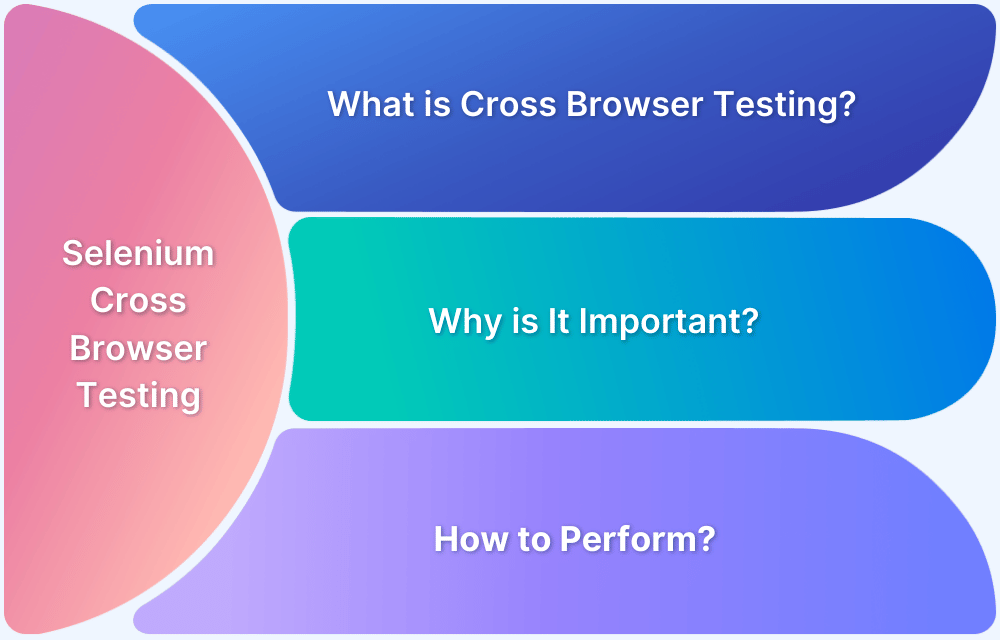Are you facing frustrating issues where your Selenium WebDriver script enters login credentials but the login still fails? This is a common challenge due to dynamic page elements, timing issues, or unexpected pop-ups blocking button clicks.
Effective login automation goes far beyond entering usernames and passwords. It ensures session stability, maintains data security, and integrates seamlessly with CI/CD pipelines.
By building robust login scripts, QA teams can create a strong foundation for all subsequent tests—from validating checkout flows to verifying personalized user dashboards—with confidence and consistency.
This guide walks you through each step of automating login functionality using Selenium WebDriver—from setting up prerequisites and configuring browsers to verifying actions and running tests on real device clouds.
Prerequisites for Login Automation using Selenium Webdriver
Login automation in Selenium offers several advantages that streamline testing and improve reliability. It saves valuable time by eliminating repetitive manual logins, while ensuring accuracy through consistent validation of authentication workflows. Automated login tests can be executed across multiple browsers and devices to guarantee cross-platform compatibility.
To successfully implement login automation, certain prerequisites must be in place before beginning with Selenium WebDriver.
- Download and Install JDK(Java Development Kit)
- Install Eclipse from the official website
- Download the Selenium Java Client version
- Configure the drivers depending on the browser. The example here will be using a chrome driver for Chrome
Read More: How to configure Selenium in Eclipse
Steps for Login Automation using Selenium WebDriver
With the prerequisites in place, the next focus is on the key steps involved in performing login automation using Selenium WebDriver.
1. Create a Selenium WebDriver instance
To launch the website in the desired browser, set the system properties to the path of the driver for the required browser. This example will use ChromeDriver for Login Automation using Selenium Webdriver. The syntax for the same will be:
Webdriver driver = new ChromeDriver();
System.setProperty("webdriver.chrome.driver", "Path of the chrome driver");2. Configure the Web browser
Usually, the web page will be in a minimized format when the test case is run. Maximize the browser for a clear picture of the test cases executed. Use the command below to do the same:
driver.manage.window.maximize();
3. Navigate to the web URL
Open the browser with the desired URL. Use the command below to open the URL in the desired instantiated browser:
driver.get("https://www.browserstack.com/users/sign_in");4. Locating the Web Element
Locators are an essential part of every Selenium script as they identify the elements that the test script will interact with to replicate user actions.
For example, let’s try to locate the email and password field of the login form of Browserstack sign in page.
Inspect the email field to locate the element using the ID locator, as shown in the image below:
Locate it via the ID locator in Selenium WebDriver:
driver.findElement(By.id("user_email_login"));Since this returns a webelement, store it in webelement variable with:
WebElement username=driver.findElement(By.id("user_email_login"));Read More: findElement vs findElements in Selenium
Repeat the same steps for the password field.
driver.findElement(By.id("user_password"));
WebElement password=driver.findElement(By.id("user_password"));5. Perform Action on the Located Web Element
After locating the element, testers need to perform the desired action. In this case, the action is entering text in the email and password fields and hitting the login button. For this, the script uses sendKeys and click methods, as shown below:
username.sendKeys("abc@gmail.com");
password.sendKeys("your_password");
login.click();Read More: How to perform Double Click in Selenium
6. Verify & Validate The Action
To validate the results, use assertion. Assertions are important for comparing the expected results to the actual results. If it matches, the test case passes. If not, then the test case fails. The syntax below will help to assert (validate) the outcome from actions by performing login automation:
Assert.assertEquals(String actual, String expected);
Save the actual URL post-login into a string value, which is:
String actualUrl="https://www.browserstack.com/users/sign_in";
The Expected URL can be identified by using the method below:
String expectedUrl= driver.getCurrentUrl();
The final assertion would look like:
Assert.assertEquals(actualUrl, expectedUrl);
If the test case is passed, it will retrieve the same. Else it will return as failed.
Given below is the full selenium code for automating login page in chrome using Selenium WebDriver:
import org.openqa.selenium.By;
import org.openqa.selenium.WebDriver;
import org.openqa.selenium.WebElement;
import org.openqa.selenium.chrome.ChromeDriver;
import org.testng.Assert;
import org.testng.annotations.Test;
public class LoginAutomation {
@Test
public void login() {
System.setProperty("webdriver.chrome.driver", "path of driver");
WebDriver driver=new ChromeDriver();
driver.manage().window().maximize();
driver.get("https://www.browserstack.com/users/sign_in");
WebElement username=driver.findElement(By.id("user_email_Login"));
WebElement password=driver.findElement(By.id("user_password"));
WebElement login=driver.findElement(By.name("commit"));
username.sendKeys("abc@gmail.com");
password.sendKeys("your_password");
login.click();
String actualUrl="https://live.browserstack.com/dashboard";
String expectedUrl= driver.getCurrentUrl();
Assert.assertEquals(expectedUrl,actualUrl);
}
}Automating login workflows using Selenium is foundational, but making those tests reliable, maintainable, and scalable requires expert insights.
Get Expert QA Guidance Today
Schedule a call with BrowserStack QA specialists to discuss your testing challenges, automation strategies, and tool integrations. Gain actionable insights tailored to your projects and ensure faster, more reliable software delivery.
Run Login Automation using Selenium WebDriver
The outlined steps form the foundation, and the next stage focuses on running the login automation using Selenium WebDriver to validate functionality in action.
import java.net.MalformedURLException;
import java.net.URL;
import java.util.HashMap;
import org.openqa.selenium.By;
import org.openqa.selenium.MutableCapabilities;
import org.openqa.selenium.WebDriver;
import org.openqa.selenium.WebElement;
import org.openqa.selenium.remote.RemoteWebDriver;
import org.testng.Assert;
import org.testng.annotations.BeforeTest;
import org.testng.annotations.Test;
public class LoginAutomation {
public static String username = "<username>";
public static String accesskey = "<access key>";
public static final String URL = "https://" + username + ":" + accesskey + "@hub-cloud.browserstack.com/wd/hub";
WebDriver driver;
String url = "https://www.browserstack.com/users/sign_in";
MutableCapabilities capabilities = new MutableCapabilities();
HashMap<String, Object> bstackOptions = new HashMap<String, Object>();
@BeforeTest
public void setUp() throws MalformedURLException {
capabilities.setCapability("browserName", "Chrome");
bstackOptions.put("os", "Windows");
bstackOptions.put("osVersion", "11");
bstackOptions.put("browserVersion", "latest");
bstackOptions.put("consoleLogs", "info");
bstackOptions.put("seleniumVersion", "3.14.0");
capabilities.setCapability("bstack:options", bstackOptions);
driver = new RemoteWebDriver(new URL(URL), capabilities);
driver.get(url);
driver.manage().window().maximize();
}
@Test
public void login() {
//driver.manage().timeouts().implicitlyWait(Duration.ofSeconds(2));
WebElement username = driver.findElement(By.cssSelector("input#user_email_login"));
WebElement password = driver.findElement(By.cssSelector("input#user_password"));
WebElement login = driver.findElement(By.name("commit"));
username.sendKeys("youremail@domain.com");
password.sendKeys("yourpassword");
login.click();
String actualUrl = "https://live.browserstack.com/dashboard";
String expectedUrl = driver.getCurrentUrl();
Assert.assertEquals(expectedUrl, actualUrl);
}
}After running the above programs, you can check the result on the Automate Dashboard page.
Why Run Selenium Login Tests using Real Device Cloud?
Testing login functionality is crucial as it is the entry point for most commercial web applications. Without login, one cannot use the application, and hence it is obligatory to test the login functionality for any authorization-based web application.
It is equally pivotal to test login functionality on the latest devices and browsers, as not all environments are the same. Devices vary in size, resolution, and capabilities, while browsers render web pages differently.
In today’s ever growing mobile market mobile and web ecosystem, it is not feasible for organizations to procure and maintain every possible device-browser combination in-house.
To address this challenge, BrowserStack Automate offers a scalable, cloud-based testing infrastructure with instant access to 3500+ real devices and browsers. It enables parallel execution of Selenium test suites, seamless integration with CI/CD pipelines, and provides advanced debugging tools such as video recordings, console logs, and screenshots. By leveraging BrowserStack Automate, QA teams can validate login flows across diverse environments with speed, accuracy, and zero setup hassle, ensuring a consistent and reliable user experience.
Conclusion
On executing the code, Selenium will navigate to the Chrome browser and open the BrowserStack login page. Then, it will log in using the relevant credentials. It will also check the test case status using Assert and try to match the URL.
Follow the steps and protocol detailed above to automate the login function of websites with Selenium. Remember to leverage the power of real browsers and devices along with Selenium’s many abilities to create immediately effective test scripts that generate desirable results with minimal time and effort.
It is always recommended to run Selenium Tests on real devices to take real user conditions into account and ensure better accuracy. BrowserStack Real Device Cloud provides access to 3500+ real devices and browsers for a seamless and comprehensive testing experience. You can also run multiple tests on different browser-device combinations with parallel testing using BrowserStack Cloud Selenium Grid.










